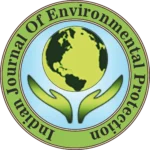IJEP 44(7): 606-613 : Vol. 44 Issue. 7 (July 2024)
Kannan Narayanan*
Hawassa University Institute of Technology, Department of Water Resources and Irrigation Engineering, Sidama Region, Hawassa, Ethiopia
Abstract
The study was conducted at Dilla Woreda to evaluate the overall drinking water quality. Stratified random sampling techniques were used based on altitudinal variations (low altitude (1350-1600 masl), mid altitude (1600-2000 masl) and high altitude (³2400 masl)) and population distribution proportion. Majorities of the population (78.3%) in the study area depend on spring as primary water source at high and mid altitudes, while at low altitude entire (100%) population depend on deep wells and surface water. The physico-chemical characters, like temperature, turbidity, total dissolved solids (TDS), phosphate and iron contents were above WHO and ES standards. Meanwhile pH, electrical conductivity (EC), total hardness (TH), nitrate, chloride, fluoride and magnesium contents here within standard limit of ES and WHO drinking water guidelines. Bacteriological analysis from the source, storage and point of use, the total coliforms differed over the three altitudinal ranges. In general, the count of coliform bacteria decreases against the altitude elevation. Specifically, relatively high amount of bacteria score were registered at source at mid and high altitudes compared to household storage and drinking points. On the other hand, on lowland, the amount of coliform bacteria scored from household storage was higher than that from the source and drinking point. At all altitudes, the status of water quality was not very good. On other hand, at high and low altitudes, 100% of the respondents were not satisfied with water service whereas in mid altitude, 86.1% of respondents were unsatisfied with water service delivered in their area.
Keywords
Water quality, Altitudinal variation, Quality satisfaction, Dilla
References
- Agnew, C. and P. Woodhouse. 2011. Water resources and development. Routledge, London.
- Tamirat, M. 2014. Determinants of households’ willingness to pay for improved water supply services in Dilla town, Southern Ethiopia: An application of contingent valuation method. MSc. Thesis. Addis Ababa University, Addis Ababa, Ethiopia.
- Demelash, W. 2010. Characterization and classification of the soils of upper sala watershed in Dilla Zuria district of Gedeo zone, southern Ethiopia. MSc Thesis. Haramaya University, Haramaya, Ethiopia.
- DTAPA. 2016. Dilla town administration population affairs, coordination and implementation core work process. Dilla, Ethiopia. (Unpublished)
- Cochran, W.G. 1977. Sampling techniques (3rd edn). John Wiley and Sons, New York.
- ES. 2002. Drinking water specifications. Quality and Standards Authority of Ethiopia.
- WHO. 2004. Guidelines for drinking water quality (3rd edn). World Health Organization, Geneva.
- WHO. 2008. Access to improved drinking water sources and improved sanitation. World Health Organization, Geneva.
- Momba, M., et al. 2006. Safe drinking water still a dream in rural areas of South Africa. Case study: The Eastern Cape Province. Water SA.32(5). DOI: 10.4314/wsa.v32i5.47864.
- Mkandawire, T. 2008. Quality of groundwater from shallow wells of selected villages in Blantyre district, Malawi. Physics Chem. Earth Parts A/B/C. 33(8): 807-811.
- Braimah, J.A. 2013. Latrines and household well water quality in Wa. Institute for Environment and sanitation studies. Environmental science programme, university of Ghana.
- Otieno, R.O., N. Ezekiel and M. Mary. 2015. Seasonal variations of physico-chemical and microbiological characteristics of groundwater quality in Ruiru, Kiambu County, Kenya. Int. J. Sci. Res., 5(12): 411-423.
- Worako, A.W. 2015. Physico-chemical and biological water quality assessment of lake Hawassa for multiple designated water uses. J. Urban Env. Eng., 9(2): 146-157.
- Kegley, E.S. and J. Andrew. 1998. The chemistry of water (2nd edn). University Science books., California. pp 13-162.
- Meseret, B. 2017. The coverage and quality of potable water supply and sanitation in rural areas of Damot Sore Woreda, Wolaita zone, southern Ethiopia. M.Sc. Thesis. Hawassa University, Hawassa, Ethiopia.
